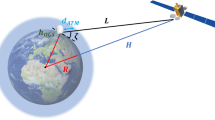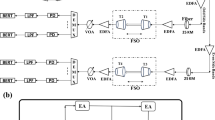Abstract
The performance of self-configured free-space-optical transceiver algorithm is investigated. The use of multiple transmitters and receiver simultaneously with various extreme weather conditions in Malaysia and Pakistan. A self-configured-transceiver (SCT) algorithm is developed to perform better in all type of extreme weather condition. The experiment is simulated in Optisystem-14, to measure the stability of performance in the presence of extreme weather. In this simulation a continuous wave and pump-laser at 1550 and 980 nm is used simultaneously with APD and PIN diode in (SCT) respectively. The performance is measured at the distance of 30 m in foggy weather condition with attenuation of (3.83 dB/km). The pump-laser with PIN diode (−8.67 dBm) performs same as CW-laser with PIN diode (−51.18 dBm). Whereas, in the same weather condition the Pump-laser with APD (84.61 dBm) and CW-laser is (2.10 dBm). These results show that multiple transmitter and receiver in SCT algorithm improve the results compare with traditional FSO system.










Similar content being viewed by others
References
Rahman, A., Aljunid, S., Anuar, M., & Fadhil, H. (2015). Improve the bit error rate performance of free space optical communication due to atmospheric turbulence effect through the robust modulation. Applied Mechanics and Materials, 699, 942–947 (Trans Tech Publ).
Yu, B. S., Yao, Y., Zhao, Y. F., Liu, C., & Yu, X. L. (2014). Simulation research of medium-short distance free-space optical communication with optical amplification based on polarization shift keying modulation. Optik, 125(13), 3319–3323. doi:10.1016/j.ijleo.2013.12.056.
Chaudhary, S., Amphawan, A., & Nisar, K. (2014). Realization of free space optics with OFDM under atmospheric turbulence. Optik-International Journal for Light and Electron Optics, 125(18), 5196–5198.
Li, Z., Cao, J., Liu, W., Feng, J., & Zhao, X. (2015). Comparison of swarm intelligence algorithms in atmospheric compensation for free space optical communication. In Selected Proceedings of the Photoelectronic Technology Committee Conferences held August–October 2014 (Vol. 9521, pp. 952114–952116). International Society for Optics and Photonics.
Dou, X., Yin, H., Yue, H., & Jin, Y. (2015). Experimental demonstration of polarization division multiplexing of chaotic laser secure communications. Applied Optics, 54(14), 4509–4513. doi:10.1364/AO.54.004509.
Bouchet, O., Sizun, H., Boisrobert, C., & De Fornel, F. (2006). Free-space optics: propagation and communication (Vol. 91). London: Wiley.
Nor, N. A. M., Islam, M. R., & Al-Khateeb, W. (2011). Analysis of the effects of environment on the performance of free space earth-to-satellite optical link in Malaysia. In Research and Development (SCOReD), IEEE Student Conference on 2011 (pp. 235–240). IEEE. doi:10.1109/SCOReD.2011.6148742.
Malik, A., & Singh, P. (2015). Comparative analysis of point to point FSO system under clear and haze weather conditions. Wireless Personal Communications, 80(2), 483–492.
Al Hajjar, H., Fracasso, B., & Leroux, D. (2011). Fiber-distributed indoor high bitrate optical wireless system. In Wireless Personal Multimedia Communications (WPMC), 14th International Symposium on 2011 (pp. 1–5). IEEE.
Win, N. L. (2014). A chromatic dispersion compensator for on-off shift keying (OOK) modulation format by mid-span spectral inversion. International Journal of Science, Engineering and Technology Research (IJSETR), 3(6), 1688–1622.
Kaur, N., & Soni, G. (2014). Performance analysis of inter-satellite optical wireless communication (IsOWC) system at 980 nm and 1550 nm wavelengths. In Contemporary Computing and Informatics (IC3I), International Conference on 2014 (pp. 1245–1250). IEEE.
Acknowledgements
The authors acknowledge Research Management Centre (RMC) of Universiti Teknologi Malaysia and Ministry of Higher Education Malaysia for facilitating in this research. We are also thankful to the Mehran University of Engineering and Technology, Jamshoro, Pakistan, for providing the communication equipment.
Author information
Authors and Affiliations
Corresponding author
Rights and permissions
About this article
Cite this article
Shah, S.M.A., Latiff, M.S.A., Chowdhry, B.S. et al. Self-Configured Free Space Optical System Transceiver Algorithm for Extreme Weather Conditions. Wireless Pers Commun 95, 539–556 (2017). https://doi.org/10.1007/s11277-016-3908-2
Published:
Issue Date:
DOI: https://doi.org/10.1007/s11277-016-3908-2




